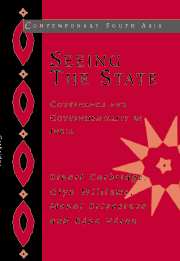Book contents
- Frontmatter
- Contents
- List of boxes, figures and tables
- Acknowledgements
- Glossary
- List of abbreviations
- Introduction
- Part I The state and the poor
- Part II The everyday state and society
- Part III The poor and the state
- Appendix 1 Major national programmes and policies related to poverty alleviation, 1999
- Appendix 2 The 1999 general election in Hajipur
- References
- Index
Appendix 1 - Major national programmes and policies related to poverty alleviation, 1999
Published online by Cambridge University Press: 22 September 2009
- Frontmatter
- Contents
- List of boxes, figures and tables
- Acknowledgements
- Glossary
- List of abbreviations
- Introduction
- Part I The state and the poor
- Part II The everyday state and society
- Part III The poor and the state
- Appendix 1 Major national programmes and policies related to poverty alleviation, 1999
- Appendix 2 The 1999 general election in Hajipur
- References
- Index
Summary
Special employment and poverty alleviation programmes
(a) Rural self-employment programmes
IRDP Integrated Rural Development Programme
50% centrally sponsored scheme with national coverage since 1980 (1976–80 pilot scheme in selected Blocks). Aims at providing self-employment through acquisition of productive assets and skills through provision of subsidy and bank credit. Targeted at rural BPL population, largely small and marginal farmers, agricultural labourers and rural artisans. Special safeguards for SC/STs, women, physically handicapped; priority to assignees of ceiling surplus land, Green Card holders under Family Welfare Programme and freed bonded labourers. Performance during Eighth Plan: total allocation (Centre and State) = Rs. 5,048 crores; 108 lakh families covered.
TRYSEM Training of Rural Youth for Self-Employment
50% centrally sponsored facilitating component of IRDP since 1979. Aims at providing basic technical and managerial skills through training. Targeted at rural BPL population between 18 and 35 years. Special safeguards for SC/STs and others, like IRDP. Performance during Eighth Plan: total allocation (Centre and State) = Rs. 370 crores; 15 lakh youth trained.
DWCRA Development of Women and Children in Rural Areas
Sub-scheme of IRDP started in 1982–3 on pilot basis, later extended to all Districts. Aims at improving living conditions of women and, thereby, of children by promoting women's income-generation activities through self-help groups and providing access to basic social services. Targeted at groups of 10 to 15 women among BPL families. 50% to SC/STs. Performance during Eighth Plan: total allocation (Centre and State) = Rs. 190 crores; 1.9 lakh groups formed; 30 lakh beneficiaries.
- Type
- Chapter
- Information
- Seeing the StateGovernance and Governmentality in India, pp. 275 - 282Publisher: Cambridge University PressPrint publication year: 2005



